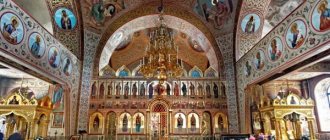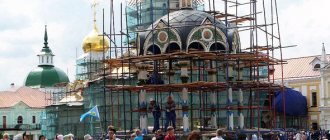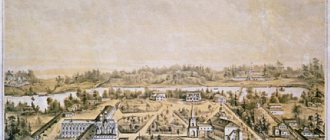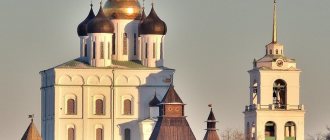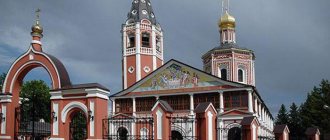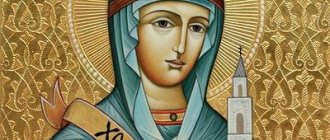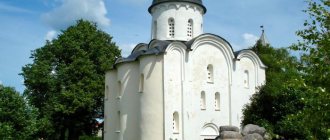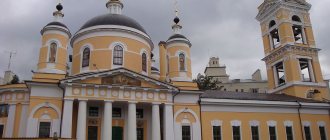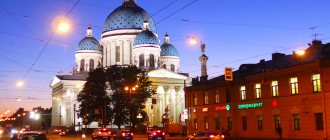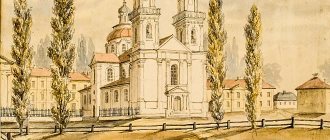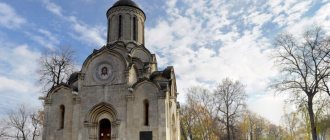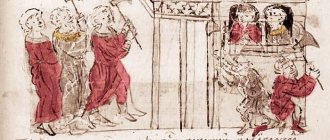Trinity churches of old Moscow
In old Moscow there were many Trinity churches associated with outstanding deeds and names of Russian history. The Trinity church was the house church in the Sheremetev Hospice House (now the Sklifosovsky Research Institute of Emergency Medicine) and the temple in his Ostankino estate, which has survived to this day. In the name of the Life-Giving Trinity, one of the side churches in St. Basil's Cathedral on Red Square was consecrated. The main altars of many Moscow churches, known from their side chapels, are dedicated to the Holy Trinity, for example, in the Sergievskaya Church of Rogozhskaya Sloboda or in the St. Nicholas Church on Bersenevka.
The Feast of the Holy Trinity is celebrated on the fiftieth day after the Resurrection of Christ, hence another name for the holiday of this great church celebration - Pentecost. On this day the Descent of the Holy Spirit took place on the Apostles, and the foundation of the Church of Christ was laid.
The holiday is dedicated to the Holy Trinity, since the Descent of the Holy Spirit on the Apostles revealed the image of the Trinitarian God and the Divine salvation of the world: God the Father created the world, God the Son saved the human race through the Atonement, and God the Holy Spirit, emanating from the Father, sanctifies the world, overshadows the Church and bestows the understanding and power of Christian preaching throughout the world.
On this day, for the first time since Easter, worshipers in the temple again kneel.
Temple in the name of the Life-Giving Trinity on Vorobyovy Gory
One of the surviving and currently operating Trinity churches is hidden on Sparrow Hills - it is well known to visitors to the observation deck in front of the Main Building of Moscow State University and to passengers crossing the Moscow River on the metro bridge. This church turns white against the background of the dense crowns of the Sparrow Hills, like on a patterned carpet, especially in autumn, and in clear weather its small domes sparkle with gold - and it seems so tiny next to the giant university. More recently, there were proposals to give this temple to Moscow University as a house church - this is how they tried to protect the Moscow State University student theater within the walls of its own house church on Mokhovaya. And no one wondered how so many parishioners could fit within the walls of a small old church at the same celebration of Tatiana’s Day.
The Trinity Church has been connected throughout its life with the history of the ancient palace village of Vorobyovo. Its current building was built at the beginning of the 19th century, but the foundation of this church dates back to very early times in Moscow history. The village of Vorobyovo has been reliably known since 1451 or 1453, when Princess Sofya Vitovtovna, the wife of Moscow Grand Duke Vasily I, bought it from “Priest Sparrow” - it is believed that the name of the village and then the entire area “Sparrow Hills” came from the name of the priest. . Moscow legends interpret this name differently: as if dense cherry orchards grew here and therefore there were many sparrows pecking at the berries. Or simply the outlying mountains of Moscow - not mountains at all, but just hills, so small that they are “mountains” not for people, but for sparrows.
Since Vorobyovo was called a “village” from the very beginning of its appearance in the history of Moscow, this means that in those days there was already an Orthodox church here. It is possible that it was the Trinity Church that stood then in the village of Vorobyovo, which became the summer palace residence of the Moscow sovereign. Ivan the Terrible's father, Grand Duke Vasily III, fell in love with this beautiful place. Back in 1521, during the invasion of Mengli-Girey, he hid here, near the wooden palace he built, in a haystack, and remained unharmed. From Vorobyov, the Grand Duke often went hunting near Volokolamsk, and while hunting in the late autumn of 1533 he became dangerously ill. The cruelly suffering prince was brought to the Vorobyovsky Palace, where he lay for two days, waiting for a bridge to be built to cross him - the ice had not yet firmly bound the river. But when the horses harnessed to the sovereign’s cart stepped onto the erected bridge, it collapsed, and the rider was miraculously not injured. He did not have long to live - the sick prince was transported on a ferry near Dorogomilov and taken to the Kremlin, where he died the next day, December 3, 1533. His son, heir John, was not even 4 years old at the time.
And when Ivan Vasilyevich turned 17 years old, he retired to his father’s shelter during a terrible summer fire in Moscow in 1547. Thus, in the Vorobyovsky Palace, Ivan the Terrible experienced the first terrible days of his reign - only six months passed after his coronation to the Russian throne. The burning city was deserted, and the rebel people rushed here, to the royal palace, but were met with cannons. This event marked the beginning of the reign of the first Russian Tsar.
The Vorobyovsky Royal Palace lived a long life. Boris Godunov, Peter I, who ordered a birch grove to be planted in his garden, and Catherine the Great loved him, but by the end of her reign in the 1790s, the palace was dismantled due to its disrepair. And twenty years later, on the Sparrow Hills, the “crown of Moscow”, according to the figurative expression of Emperor Alexander I, the construction of the Cathedral of Christ the Savior according to the design of A. Vitberg began - their first “great construction”.
Trinity Church, which became one of the local palace churches, witnessed all these events. It was mentioned in 1644 as a very ancient church that had long stood in Vorobyovo. The fact is that along with it there were 2-3 more palace churches. One day they were all dismantled and in their place they built one Trinity Church with side altars. But the current church building, built only in 1811, has seen a lot in its lifetime. Already in 1812, M.I. himself prayed in it. Kutuzov before going to the military council in Fili. According to legend, this area has been associated with the Kutuzov family since ancient times. The village of Golenishchevo, neighboring Vorobyov, with another, also Trinity Church, in the area of modern Mosfilmovskaya Street, and from the 15th century became part of their old boyar surname - as if the Moscow Metropolitan Jonah healed the boyar Vasily Kutuzov there, and this miracle was depicted in one of the hallmarks local icon of the saint in the Trinity-Golenishchevsky Church. That is why the descendants of the healed boyar began to be called Kutuzov-Golenishchev.
And the Trinity Church in Vorobyovo survived even after Napoleon himself came here to look at the panorama of Moscow, which lay at the foot of the Vorobyovy Mountains. The completion of the construction of the Trinity Church is sometimes attributed to the famous “holy doctor” F. Haas, who took such care of the prisoners of the local transit prison, built from former barracks for construction workers of the Witberg Cathedral of Christ the Savior. He wanted the prisoners to be somehow assigned to this church, to have the opportunity to attend services and be cared for by its priests.
The Trinity Church, remote from the center, miraculously survived during Soviet times - although the Bolsheviks paid attention to the Sparrow Hills (somewhere here was the dacha of Lunacharsky himself, and then Khrushchev) and attached great importance to the urban planning plans of the new, socialist Moscow. It was none other than L.B. who proposed renaming the Sparrow Hills to Lenin Hills. Krasin in February 1924, after Lenin's death. He also gave the idea to erect a giant monument to the leader and build a palace in his name. These plans of Krasin later formed the basis for the idea of the Palace of Soviets, for which, by the way, Vorobyovy Gory was also proposed at one time.
And according to the notorious General Plan for the Socialist Reconstruction of Moscow in 1935, the Lenin Hills were the final, final part of the supposed main main thoroughfare of the new city - Ilyich Avenue, passing through the center of Moscow and the Palace of Soviets. According to the authors of the project, the Lenin Mountains became the main vacation spot for Muscovites. “Imagine a mass holiday in socialist Moscow, when tens of thousands of vacationing proletarians will walk along Ilyich Alley, rejoice on the fields of mass events, and relax on the water. The aerial cableway carries more and more Muscovites over the Moscow River to the green Lenin Mountains, from where a magical panorama of the new Moscow opens, no longer without the shiny copper dome b. Church of the Savior, but with a towering silhouette of metal, concrete and glass - the majestic building of the Palace of the Soviets,” wrote one enthusiastic apologist for the 1935 General Plan.
However, the Trinity Church not only survived socialist destruction, but was not even closed during Soviet times, so its ancient interior has been preserved. Moreover, after the well-known Bolshevik ban on bell ringing throughout Moscow, it was in the Vorobyov Trinity Church that bells continued to ring - since it was then located outside the administrative city limits. And Orthodox Muscovites secretly went “to the Lenin Mountains” to listen to the blessed ringing on this miraculously remaining reserved island of old Moscow. Once again, Trinity Church survived the construction of a high-rise building at Moscow State University in the late 1940s - early 1950s - and such construction usually spared no one or anything.
Church of the Life-Giving Trinity in Listy
Among other Moscow Trinity churches, the beautiful and slender Church of the Holy Trinity in Listy, on the corner of Sretenka and Sukharevskaya Square, is remarkable for its history. The temple on this site has been known since 1635, and its surviving building was built after 1661. Under Tsar Alexei Mikhailovich, a streltsy regiment was stationed here nearby, and from the Palace Order the tsar granted the streltsy 150 thousand bricks for the construction of the temple - for the capture and bringing of Stepan to Moscow Razin.
At the end of the 17th century, the Streltsy regiment was headed by L. Sukharev, in whose honor under Peter I the famous Sukharev Tower was erected nearby, because the Sukharevsky regiment remained faithful to the young tsar during the rebellion. In 1689, Peter granted the archers 700 rubles for the repair of the Trinity Church for the capture of the rebel Fyodor Shaklovity.
In Moscow, this temple was also famous for the fact that near it they sold the best bergamot tobacco in the city, which was made by the church sexton according to a special, unknown recipe. One day, the Frenchman Olivier came to Trubnaya Square to buy such exquisite tobacco and met there one of the Pegov brothers, also a passionate lover of bergamot tobacco. The acquaintance was a success, and soon Pegov acquired a plot of land on Trubnaya and opened the Hermitage restaurant, which was headed by the culinary specialist Olivier, the author of the famous salad. Moscow students annually celebrated their Tatiana Day in this favorite restaurant.
And another blue and white Trinity Church in Serebryaniki is located on small Yauzskaya Street between Solyanka and Kotelniki - right opposite the local “high-rise”. In the 17th century, there was a Money Court here, where the royal silver coins were minted and master silversmiths lived. This is where the name of the area comes from. The church appeared here even before the Romanovs, and in 1781 it was rebuilt by the famous Moscow architect K.I. Blank. It is interesting because in 1768 its bell tower was built at his own expense by the great-great-grandfather of Pushkin’s wife, Afanasy Goncharov, who had his own estate and linen factory nearby. In this bell tower, Goncharov built a small side church in the name of St. John the Baptist for the commemoration of parents. There is a version that the Goncharovskaya bell tower has survived to this day with some changes, while another believes that Blank dismantled the old bell tower and built a new, modern one. Previously, there was also a tower clock with chimes on it, that is, with chimes. It is also noteworthy that it was in this boiler room Trinity Church at the turn of the 19th – 20th centuries that electricity was first used to illuminate worship services: small electric light bulbs were installed in the church chandeliers.
Of the destroyed Trinity churches, we will remember the temple that had the old Moscow name on Kapelki, which stood on 1-Meshchanskaya Street (in Soviet times - Prospekt Mira). Legend has it that in the old days there was an ordinary Moscow tavern here - a circle courtyard, or, as they said in Moscow, a circle. The kisser, his owner, was a very pious man and decided to renovate the old local church - he began to ask each of his guests to pour a drop from his glass onto the temple. Peter heard about this and went to the kisser himself. He did not recognize the king and also asked him to drain a drop. The king asked him why he was asking this, and the old kisser answered him that he was collecting money for the church drop by drop. Peter donated money to him, and so the new Trinity Church on Kapelki appeared.
Historians explain this old Moscow toponym differently, since the church was called “what’s on Kaplya” back in 1625 - long before the birth of Tsar Peter I. According to scientific findings, the name came from the name of the local stream Koptelka, or from the small river Kaplya, a tributary the Naprudnaya River, which supplied water to the famous local ponds of the palace Naprudnaya Sloboda, where the surviving Trifonov Church was built in ancient times (see February 14).
It is interesting that Peter I actually took part in the fate of the Trinity Church on Meshchanskaya. In 1708, the old wooden church burned down, and by order of the tsar, a new one was erected in just 4 years - Empress Catherine herself, Peter’s wife, donated funds for it.
In 1931–1933, the Trinity Church on Kapelki was demolished and an ordinary residential building was built in its place.
Interesting facts and legends
The Trinity Cathedral of the Trinity of Sergius Monastery is surrounded by the most interesting myths and legends.
The story, the authenticity of which cannot be reliably established, according to apocryphal sources, occurred after several clergy and members of the parish, under the leadership of the monastery minister Father Pavel Florensky, as well as lay art critic Yuri Olsufiev, learned about the impending desecration of the shrine and fearing a terrible outcome, according to With the blessing of Patriarch Tikhon, they decided to enter the cathedral and steal the head of Sergius of Radonezh, replacing it with a skull from the family crypt of the Trubetskoy family, which was located on the territory of the monastery...
According to another version, the conspirators carried out the plan to steal the head of St. Sergius in 1920, after the relics were put on public display.
The head of the founder of the monastery was transported to the sacristy, after which Yuri Olsufiev, who lived in Sergiev Posad, left the shrine for preservation at his home, where it remained until 1928, until it was buried by him in the garden.
The persecution of the authorities forced him to flee, but he managed to convey what only Olsufiev himself knew - the address and location of the sacred relic - to Novgorodian Pavel Ogurtsov (in the future - Novgorod Bishop Sergius), who became a member of the sacred mission.
Pavel Ogurtsov did not renounce his mission and came to the indicated place, to the Olsufiev estate in Sergiev Posad, where he found the designated place in the garden and dug up a great treasure - an oak casket in which the head of St. Sergius was kept.
You need to understand that all active participants in the resistance were sooner or later caught and punished. The first was Father Pavel Florensky, convicted in 1933, and in 1938 Olsufiev was sent to prison.
The main custodian of the sacred object remained P. Ogurtsov, who, on the eve of his departure to the front, transported the head to the village of Vinogradovo, in the urban district of Mytyshchi.
However, even before the start of the Second World War, the relics were returned to the shrine and were transferred to the Trinity Cathedral, but the cathedral itself at that time was simply part of the exhibition of the Zagorsk Historical Museum. However, at the end of the war, the Soviet government noticeably softened its attitude towards the Lavra and already in 1946 the monastery was reopened, and later the relics of St. Sergius were returned there.
Then, on Easter, a heavy shrine with relics, which weighed up to sixty pounds, was dragged on one hand to the Assumption Cathedral and the first service in a long time was held. Thus, the Trinity-Sergius Lavra finally returned to the fold of the Russian Orthodox Church.
